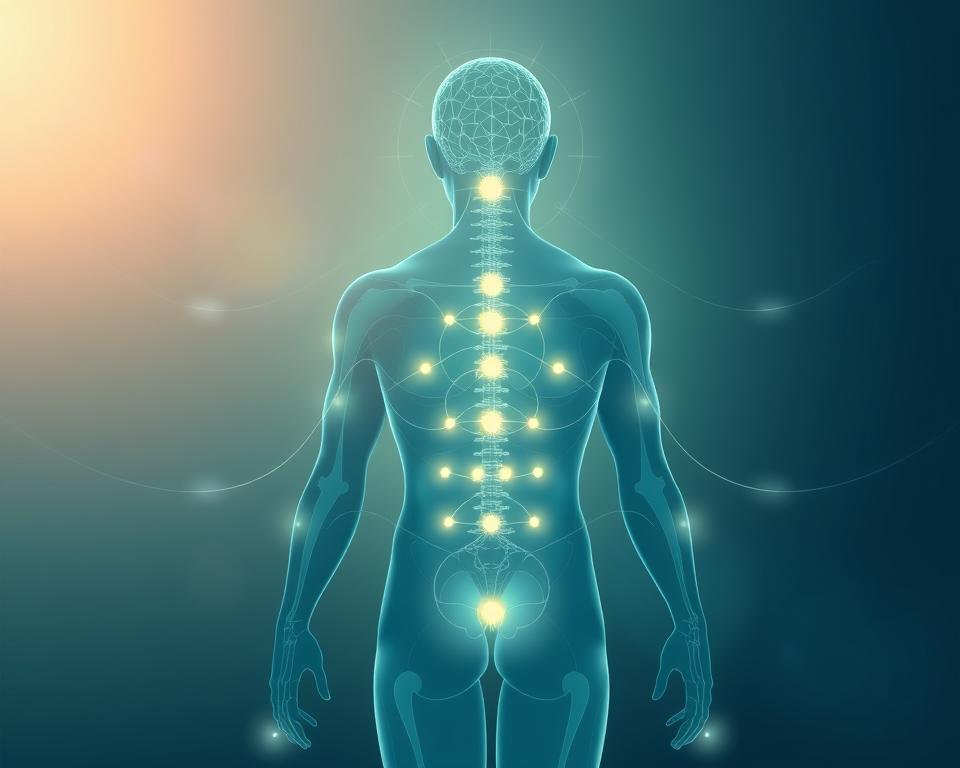Acupressure for Colds and Flu: Natural Relief Guide

Are you looking for a natural way to ease cold and flu symptoms? Acupressure, an ancient Chinese healing art, is here to help. This guide shows how acupressure can boost your immune system and ease respiratory issues. It’s a drug-free way to manage viral infections and support your traditional Chinese medicine.
Acupressure works by applying pressure on certain body points. It unlocks your body’s healing power and leads to lasting wellness. If you’re fighting a cough, congestion, or just want to boost your immunity, this guide has you covered.
Learn about acupressure’s history and its link to traditional Chinese medicine. Discover acupressure points and routines for your symptoms. Use acupressure’s natural healing power to regain your health, avoiding harsh meds and invasive treatments.
Read more interesting information at ::googrekas
Understanding Acupressure and Its Benefits
Acupressure is a traditional Chinese medicine practice that focuses on wellness. It uses pressure points on the body. Unlike acupuncture, acupressure doesn’t use needles. Instead, it uses fingers, palms, elbows, or tools to apply pressure.
Acupressure is based on the idea that our bodies have energy channels. These channels, or meridians, control our health and well-being. When these channels are blocked, health problems can occur, including respiratory issues. By pressing certain points, acupressure aims to restore energy flow and balance.
What is Acupressure?
Acupressure is a safe, drug-free therapy. It involves applying manual pressure to specific body points. These points, called acupoints, connect to the body’s energy channels. By targeting these points, acupressure can help with many health issues, including respiratory problems.
Acupressure’s Role in Traditional Chinese Medicine
In Traditional Chinese Medicine, acupressure helps balance the body’s energy. TCM believes that when energy flow is disrupted, health problems can arise. Acupressure aims to unblock and harmonize these energy channels, restoring balance.
By stimulating acupoints, acupressure can help with respiratory symptoms and boost the immune system. It’s a key part of a holistic approach to health and wellness.
Acupressure Points for Respiratory Health
Acupressure, based on traditional Chinese medicine (TCM), can help with cold and flu symptoms. It targets specific points to offer natural relief and support your body’s healing.
Lung Meridian Points
The Lung meridian is key in TCM for the respiratory system. Stimulating these points can ease symptoms like nasal congestion, coughing, and breathlessness:
- LU1 (Central Breathing) – Located on the chest, just below the collarbone. Helps regulate breathing and strengthen the lungs.
- LU9 (Great Abyss) – Found on the wrist, this point can help clear mucus and soothe a sore throat.
- LU7 (Broken Sequence) – Situated on the inside of the wrist, this point can aid in reducing fever and easing respiratory distress.
Large Intestine Meridian Points
The Large Intestine meridian is also linked to respiratory health in TCM. Targeting these points can offer relief for cold and flu symptoms:
- LI4 (Union Valley) – Located on the hand, between the thumb and index finger. Effective for alleviating nasal congestion and sinus pressure.
- LI11 (Crooked Pond) – Found on the elbow, this point can help reduce fever and ease coughing.
- LI20 (Welcome Fragrance) – Situated at the outer edge of the nostril, this point can help open the nasal passages and clear mucus.
Adding these acupressure points to your self-care can help with colds, flu, and other respiratory issues. Always talk to a healthcare professional for personalized advice and safe use of acupressure.
Acupressure for Colds and Flu
As the seasons change, cold and flu season arrives. Many look for natural ways to feel better. Acupressure, an ancient Chinese method, is becoming popular for its drug-free approach to fighting viruses.
Acupressure is similar to acupuncture but uses pressure instead of needles. It targets specific points on the body’s energy paths. These points help balance the body’s energy, or qi, and can ease cold and flu symptoms.
Using acupressure can help in many ways:
- Alleviate nasal congestion and sinus pressure
- Soothe sore throats and reduce coughing
- Manage fever and chills
- Boost the immune system to aid in recovery
Adding acupressure to your routine can be a great natural remedy. It lets you fight colds and flu without drugs.
| Acupressure Point | Symptom Relief |
|---|---|
| Large Intestine 4 (LI4) | Relieves nasal congestion, sinus pressure, and headaches |
| Throat Meridian Points | Soothes sore throat and reduces coughing |
| Lung Meridian Points | Eases chest congestion and improves respiratory function |
| Stomach 36 (ST36) | Boosts immunity and aids in recovery |
Learning and using these acupressure techniques can help you fight cold and flu symptoms. You don’t need to use medicines.
“Acupressure is a safe, natural, and effective way to manage the symptoms of colds and flu, empowering individuals to take a proactive approach to their health.”
Boosting Immunity with Acupressure
Acupressure is an ancient healing method from Traditional Chinese Medicine. It’s a natural way to boost your immune system. By pressing certain points, you can help your body fight off cold and flu viruses.
The Spleen 6 (SP6) point is key for immunity. It’s on the inner leg, just above the ankle. Pressing this spot gently for a few minutes daily can help your immune system.
The Large Intestine 4 (LI4) point, also known as the “Hand’s Commandment” point, is another important spot. It’s between your thumb and index finger. This point helps balance your body’s energy and releases toxins, making your immune system stronger.
| Acupressure Point | Location | Benefits |
|---|---|---|
| Spleen 6 (SP6) | Inner leg, above the ankle | Regulates the spleen, improves immune function |
| Large Intestine 4 (LI4) | Between thumb and index finger | Balances energy, promotes toxin release, boosts immunity |
Adding these acupressure techniques to your wellness routine can help your body fight off viruses. Discover the benefits of this ancient practice and strengthen your immune system.
Complementing Acupressure with Other Natural Remedies
Acupressure is a strong natural way to handle cold and flu symptoms. But, it gets even better when you add herbal teas, supplements, and lifestyle changes. These can help your body fight off illness and feel better.
Herbal Teas and Supplements
Some herbal teas and supplements can help with acupressure. They can ease breathing problems and boost your immune system. Here are a few good ones:
- Ginger tea: It’s known for reducing inflammation and soothing sore throats and congestion.
- Turmeric supplements: They have strong antiviral and anti-inflammatory effects, helping your body’s defenses.
- Elderberry syrup: It’s full of antioxidants and can shorten and lessen flu symptoms.
Rest and Hydration
Rest and staying hydrated are key when you’re sick. They help your body heal. Make sure to:
- Get enough sleep to help your body fight the infection.
- Drink lots of water, herbal teas, and soups to stay hydrated and remove toxins.
Using acupressure with these natural remedies can help you feel better. It’s a great way to take care of yourself during cold and flu season.
Acupressure for Fever Relief
Fever from colds and flu can be tough to handle. Luckily, acupressure is a natural way to ease these symptoms. By pressing certain points, you can lower your temperature and feel better.
Cooling Acupressure Points
Acupressure has special points for fever relief. These points cool the body and offer comfort.
- Large Intestine 4 (LI4) – On the hand, between thumb and index finger. It clears heat and calms the body.
- Pericardium 6 (PC6) – On the inner forearm. It reduces fever and eases chest pain.
- Spleen 6 (SP6) – On the inner lower leg. It cools the body and regulates temperature.
Pressing these points gently can bring a soothing feeling. It helps ease fever discomfort. Be gentle and find what works for you.

“Acupressure is a powerful tool for managing fever and other cold and flu symptoms. By targeting the right points, you can find natural relief and support your body’s healing process.”
Easing Nasal Congestion with Acupressure
Feeling stuffy in your nose is a common problem when you have a cold or flu. But, acupressure from traditional Chinese medicine can help. It targets special points on your body to clear your nose and make breathing easier.
The acupressure point for stuffy noses is called the Large Intestine 4 (LI4). It’s on the back of your hand, between your thumb and index finger. Press it gently with your thumb for 2-3 minutes while you breathe deeply. This can help your body heal and clear your sinuses.
- The Yingxiang (LI20) point, just outside your nostril, is also good. Massage it gently to open your nose.
- Pressing the Ren 22 (Tiantu) point at the base of your throat can also help with nasal congestion.
Using these acupressure techniques can help you feel better when you have a cold or flu. They work well with other natural remedies. Acupressure is a great tool to have when you’re fighting off respiratory illnesses.
| Acupressure Point | Location | Benefits for Nasal Congestion |
|---|---|---|
| Large Intestine 4 (LI4) | Back of hand, between thumb and index finger | Stimulates the body’s natural healing response and promotes sinus drainage |
| Yingxiang (LI20) | Just outside the nostril | Helps open up the nasal passages |
| Ren 22 (Tiantu) | Base of the throat | Provides relief from nasal congestion |
“Acupressure is a simple, yet powerful technique that can help alleviate the discomfort of nasal congestion without the use of medications.”
Acupressure for Sore Throat and Cough
Colds and flu can make your throat sore and coughing hard. Luckily, acupressure is a natural way to help. It works by pressing on special points to help your body heal.
Throat Meridian Points
The Throat meridian runs along your neck and throat. Pressing these points can ease a sore throat and stop coughing. Here are some important points to try:
- CV22 (Tongue Tie): This point is in the throat’s center, above the breastbone. It can help with a sore throat and cough.
- CV23 (Celestial Window): Below the Adam’s apple, this point can help with a hoarse voice and throat pain.
- LI18 (Neck Abyss): Behind the earlobe, this point can reduce throat swelling and pain.
Massaging these points can make your throat feel better. It can help with sore throats and coughs from colds and flu.
While acupressure is helpful, see a doctor if your symptoms don’t get better. Using acupressure with herbal teas and rest can help manage cold and flu symptoms.
Precautions and Safety Considerations
Acupressure is safe and effective for managing colds, flu, and viral infections. It’s important to know some precautions and safety tips. This way, you can use acupressure safely and effectively in your illness management.
Consult a Healthcare Professional
Before starting acupressure for colds, flu, or any health issue, talk to a healthcare professional. This could be a licensed acupuncturist or a traditional Chinese medicine practitioner. They can guide you on the right acupressure points and techniques for your symptoms and health.
Avoid Certain Conditions
- If you have bleeding disorders or take blood-thinning medications, avoid acupressure. It may increase the risk of bruising or bleeding.
- Pregnant women should talk to a healthcare provider before using acupressure. Some points may not be safe during pregnancy.
- People with open wounds, skin infections, or other acute conditions should not use acupressure in those areas. It could lead to further complications.
Proper Technique and Hygiene
When using acupressure for viral infections, follow proper technique and keep good hygiene. Make sure your hands are clean. Avoid pressing too hard or irritating the skin. If you feel any discomfort or have adverse reactions, stop and talk to a healthcare professional.
By following these precautions and safety tips, you can safely use acupressure in your illness management. This empowers you to manage colds, flu, and other viral infections in a holistic way.

Ancient Healing Practices for Modern Times
In today’s fast world, we often forget the wisdom of ancient healing. Acupressure offers a timeless way to wellness that fits into our busy lives. It uses traditional Chinese medicine methods to help our health and strength.
Integrating Acupressure into Your Wellness Routine
Adding acupressure to your daily routine is easy and effective. It uses ancient healing practices for holistic wellness approaches. Just a few minutes a day can greatly improve your health.
- Explore the lung meridian points to support respiratory function and alleviate cold and flu symptoms.
- Stimulate the large intestine meridian points to boost your body’s natural defenses and enhance immunity.
- Incorporate acupressure into your self-care routine, whether it’s during your morning routine, lunch break, or evening wind-down.
By integrating acupressure into your wellness routine, you can use ancient wisdom for today’s health challenges. This holistic approach can help you face colds, flu, and more. Discover the power of ancient healing practices for your well-being.
Step-by-Step Acupressure Routines for Colds and Flu
Looking for natural ways to fight cold and flu symptoms? Acupressure is a great option. It uses specific points on the body to ease common problems. Let’s explore some easy acupressure routines to help you feel better.
Boosting Immune Function
To boost your immune system, focus on the Large Intestine 4 and Spleen 6 points. Press these spots gently for 2-3 minutes. This helps your body fight off sickness better.
Relieving Nasal Congestion
For stuffy noses, try the Large Intestine 20 points above your nostrils. Press firmly for 1 minute, then switch sides. This can clear your nasal passages and ease breathing.
Soothing a Sore Throat
To calm a sore throat, use the Lung 7 points inside your wrist. Press lightly for 2-3 minutes. This can help soothe throat pain.
Reducing Fever
To lower fever, press the Large Intestine 4 and Pericardium 6 points. Hold for 2-3 minutes. This can help cool down your body and ease fever discomfort.
Consistency is key with acupressure. Practice these routines often. Be patient as your body starts to heal naturally.
“Acupressure is a powerful tool for supporting the body’s natural healing processes and finding relief from common ailments. By tapping into the body’s energy pathways, we can unlock a wealth of natural wellness benefits.”
| Acupressure Point | Benefit | How to Apply |
|---|---|---|
| Large Intestine 4 | Boosts Immune Function | Apply firm pressure for 2-3 minutes |
| Spleen 6 | Strengthens Immune System | Apply firm pressure for 2-3 minutes |
| Large Intestine 20 | Relieves Nasal Congestion | Apply firm pressure for 1 minute on each side |
| Lung 7 | Soothes Sore Throat | Apply light pressure for 2-3 minutes |
| Pericardium 6 | Reduces Fever | Apply firm pressure for 2-3 minutes |
Acupressure and Traditional Chinese Medicine Methods
Acupressure is a key part of Traditional Chinese Medicine (TCM). It focuses on keeping energy, or “qi,” flowing well in the body. This approach is all about balance and health.
The Holistic Approach to Wellness
TCM sees the body as a connected system. Organs, meridians, and energy paths work together for health. Acupressure targets these points to fix problems, not just symptoms.
By pressing on these points, acupressure helps the body heal itself. It boosts the immune system and brings balance back. This is great for fighting off colds and flu.
| Traditional Chinese Medicine Methods | Holistic Wellness Approaches | Complementary Therapies for Viral Infections |
|---|---|---|
| Acupressure | Meridian balancing | Immune system support |
| Herbal remedies | Mind-body integration | Symptom management |
| Qi Gong exercises | Stress reduction | Respiratory function improvement |
Using TCM’s holistic ideas, people can use acupressure and other therapies. They help the body fight off viruses and improve overall health.
Complementary Therapies for Viral Infections
There are many ways to help your body fight off colds and flu besides acupressure. These include ancient healing practices and holistic wellness approaches. They offer drug-free ways to manage illness and help you take control of your health.
Herbal medicine is one such therapy. For centuries, herbs like echinacea, ginger, and elderberry have helped with respiratory issues and boosted immunity. You can use them in teas, tinctures, or supplements to help fight viral infections.
Aromatherapy is another holistic method. Essential oils like eucalyptus, peppermint, and tea tree oil can be used to ease symptoms and improve breathing. These oils have antimicrobial and anti-inflammatory properties, making them great for wellness plans.
| Complementary Therapy | Benefits for Viral Infections |
|---|---|
| Herbal Medicine | Antiviral properties, immune system support |
| Aromatherapy | Antimicrobial and anti-inflammatory effects |
| Mindfulness and Meditation | Stress reduction, improved sleep, and immune function |
| Hydrotherapy | Fever reduction, decongestant effects |
Mindfulness and meditation are also important. They help reduce stress and improve sleep, which are key for fighting off viruses. These practices support the immune system and help the body heal.
Hydrotherapy is another useful approach. It includes using hot and cold compresses, steam inhalation, and contrast baths. These methods can ease respiratory symptoms, lower fever, and clear sinuses.
By adding these therapies to your wellness routine, you can use ancient healing practices to support your body. This way, you can manage viral infections more effectively.
Conclusion
Acupressure for colds and flu is a natural way to feel better. It uses pressure on certain points to help your body fight off viruses. This can ease nasal stuffiness, soothe sore throats, and even lower fever.
Adding acupressure to your health routine helps you manage viral infections better. It works well with other natural remedies like herbal teas. These can help your body recover faster.
Wellness is about finding the right mix of old and new medicine. Traditional Chinese Medicine teaches us to trust our bodies’ healing powers. Acupressure is a key part of this, offering natural relief when we need it most.







